- December 31, 2021
- By BitByBit
- In Articles
- No Comment
- 0
The Breakdown of Brute Demon Hunter
(A Hearthstone Deck Guide)
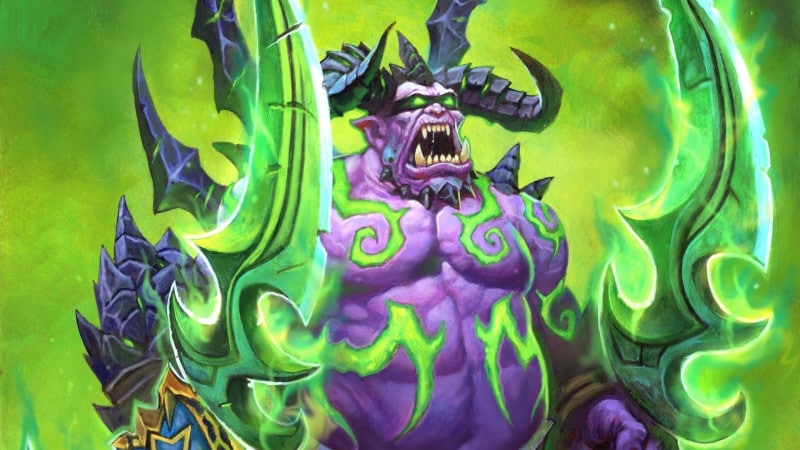
After the whole expansion of United in Stormwind and a nerf from 7 mana to 8 mana Brute Demon Hunter is still quite playable and a reasonable position against decks that hold their resources/ combos in hand. You may have seen the deck being played still by many streamers such as Lambyseries, Reqvam, and also myself (BitByBit) at high legend. It has also been seen at many tournament lineups still. Yet, even with so much time since the creation of this deck, there are still many players that struggle to pilot the deck. Current stats show Brute Demon hunter at a 45.5% win rate out of 820 games since the 22.2 patch across all ranks. So, as the creator of the deck and still playing it at top 200 legend, I’d like to give an in-depth insight and direction on how to go about playing the deck.
On the surface, the deck seems to just draw through the deck, complete the questline as soon as you can and play some Irebound Brute along the way into a lion’s frenzy. However, the deck is actually about mana reduction and often feels like you must forget your hearthstone fundamentals (playing for board, holding back resources, and at times considering opponent’s plays). The deck is heavily focused on a player’s ability to plan ahead, think quickly on their feet and their APM “actions per minute”. Every deck slot revolves around the quest which reduces the mana cost of cards which furthers the setup of completion of the other phases of the quest line and the final reward of Kurtrus to set up the huge (15+ attack) “Lion’s Frenzy”. Along the way you may deviate from the quest line progressions in order to put a “Brute” into play. The “Brutes” themselves can be a win condition, but are often there to stall the game until the quest line is complete.
Table of Contents
Understanding Card selection
Taking a look at the card choice and ignoring the mulligan WR/ kept percentage. I’ll explain in further detail why it can be confusing and how it depends more on the combination of cards you have in your hand.
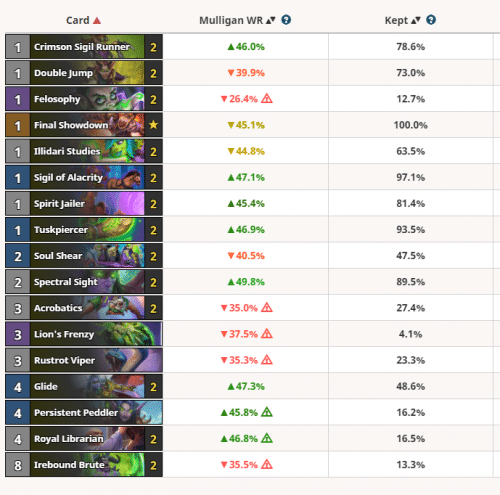
The current list is 26/30 perfect in my opinion. Most of the cards are just “draw a card”, but a few synergies/ card selections require a bit more elaboration:
» Lion’s Frenzy
- Post questline completion win condition. Avoid drawing or playing it post quest completion.
- Avoid playing before both “Tusk Piercer”
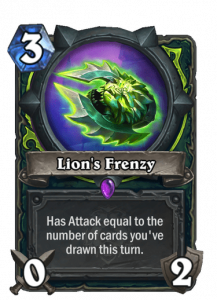
» Irebound Brute, Felosophy & Spirit Jailer
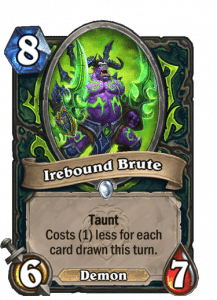

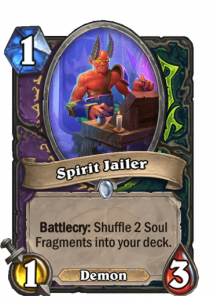
- “Felosophy” ideally is to copy brutes, but often copying “Spirit Jailers” for developing stats on board can help contest early game. In addition, the “Soul Fragments” further enables discounts of the “Brutes”, questline completion and additional attack for the “Lion’s Frenzy”.
- “Feloposy” also copies the mana discounts of the “Brutes” and “Jailers”
» 2 Tuskpiercer and 1 Persistent Peddler
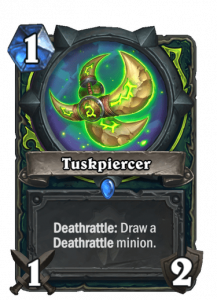
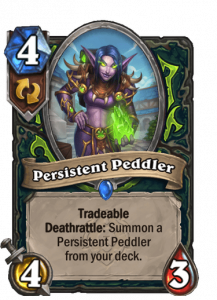
- This package is here to ensure consistent draw. “Tusk Piercer” always draws the “Peddler” and the “Peddler” is tradable ensuring 1 mana to draw 1 card. Thus contributing to the deck’s game plan of drawing cards to cheat mana and to complete the questline.
- Note: Cheat mana here is used in the context of being able to draw the “peddler” without having to pay mana.
- “Tusk Piercer” should be kept at 1 durability to control when you want to draw the “Peddler”
» Glide
- This is a disruption card against control and combo decks when in the “outcast” position.
- It is important to note that one glide at the start of a turn will complete every stage of the quest line. However, Glides should be used sparingly. Try to have at least 1 glide for post Questline Completion, as it allows you to shuffle the cards in hand back into your deck which reduces the cost by 2 due to the “Kurtrus” quest reward.
- Playing “Glide” also allows the reset of a hand with many non draw cards such as “Lion’s Frenzy” and the “Brutes” that would make playing the hand awkward.
- It is also a good rate for draw “using 4 mana to draw 4 cards”
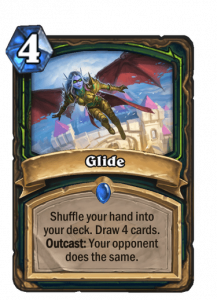
» Flex Spots
The flex spots are the 2 “Soul Sheers”, 1 “Rustrot Viper”, and 1 “Royal Librarian”. There are various lists that run “Need For Greed”, “Immolation Aura”, “Fel Barrage”, or even “Safety Inspector”. The current list probably has the best balance that leans into the deck’s game plan of drawing cards to cheat mana. The Soul Sheers add “Soul Shards” to your deck and 3 health is a common health breakpoint from minions from turns 1 through 3. “Rustrot Viper”, along with it’s tradable tag, is great against weapon decks such as Weapon Rogue and Paladin’s Hero Card, Cariel’s immovable object weapon. The “Royal Librarian” is also great for unfreezing your minions and getting through taunts.
General Game Flow
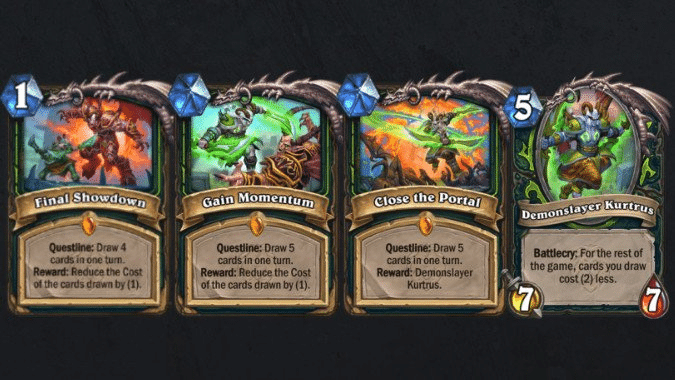
Typically the questline will be complete in the following order: phase 1 ( draw 4 cards in 1 turn) of the questline on turn 3, phase 2 (draw 5 cards in 1 turn) on turn 4, and phase 3 (draw 5 cards in 1 turn) on turn 5 with “Kurtrus” being played on turn 6. However, it is normal to consider deviating from these steps based on luck of cards draw (drawing good card draw, or getting no card draw), trying to play/ setup a “Brutes” on board, or even drawing “Soul Fragments” for heal/ quest completion. You may even be able to complete multiple questlines stages in 1 turn.
During each attempt of completion of the quest phase you will be aiming to play cards from the left as the cards you draw from the right will be discounted by the completion of the questline stage. Also, note that all cards drawn in the process of completion of the first and second phase of the questline will get discounted. For example, if you’ve drawn 6 cards while completing the second phase, the quest will reduce the cost of drawn cards that are still in your hand.
Understanding Mulligans
- Keeping in mind the idea the deck’s game plan, you keep “Tusk Pericer” and “Sigil of Alacrity” 100% of the time
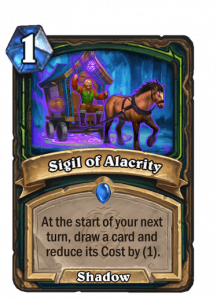

- However, you don’t hard mulligan for these cards as your mulligan should be focused on keeping cards that ensures that you can complete the first stage of the questline.For example this hand would be a keep:
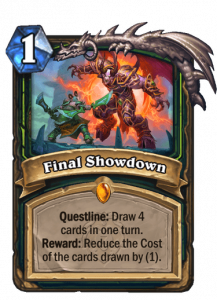
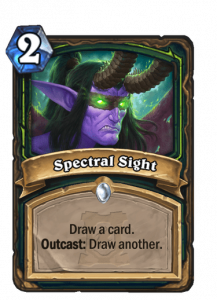

- Cards to consider keeping:
- Tradables cards: as drawing them during the completion of a questline phase doesn’t reduce the cost of the tradable effect as it will always be 1.
- “Illidari Studies” if the left side of the hand is easily played to play the discovered outcast card, or if you have glide in your hand going into a combo/ control match up.
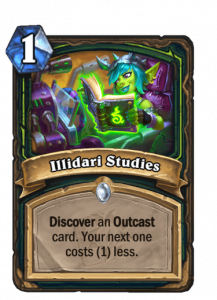
Example hand of Studies keep:



- 80% of the time you do not keep “Double Jump” as it is an unconditional draw 1 that can be reduced to 0 through the completion of the questline phases.
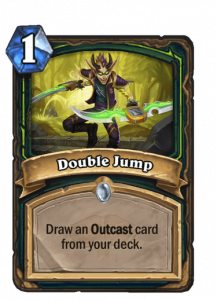
- Cards to never keep in mulligan: “Lion’s Frenzy”, “Felosophy”, “Irebound Brutes”, and “Acrobatics”.




Match Up Notes
- Typically in most matchups you will still be trying to complete the questline in the standard turn 3. 4. 5.
- Against combo decks, (Mozaki Mage, Garrote Rogue, Etc) “Glide” is a keep if it can be easily outcasted.
- Against aggro, it is reasonable to keep “Spirit Jailer” to contest early board. Even keeping soul sheer is reasonable if you are certain that there is a snowball card in the early game like “Irondeep Trogg”. However keep in mind that slowing down your opponent’s game plan should at least be enabling or progressing your own game plan.
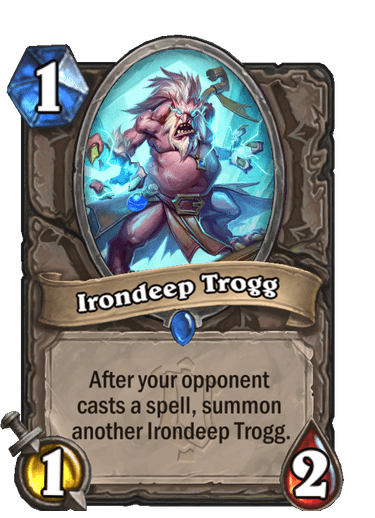
In Depth Phases of each Turn
» Turn 1
- 90% of the time you’ll be playing the quest.
- Exceptions to this are:
- Playing “Spirit Jailer” in aggro match up.
- Playing “Illidari Studies” with an ideal hand as shown in the mulligan example.
- Playing “Coin” + “Tusk Piercer”’ with hero power/ “Soul Shard” to contest a snowballing minion. One example is “Intrepid Initiate” in a board buff deck like hunter.
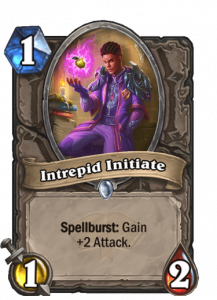
» Turn 2
- Setup turn for the first phase of the quest line to draw 4 cards in 1 turn.
- Often you’ll be equipping the “Tusk Piercer” and attacking to change its durability to 1. Playing the “Sigil of Alacrity”. It is common to even just hero power this turn.
- The hand should be set up in a way to have your outcast drawn cards to the left or have access to tradable cards to draw with.
» Turn 3
- 1st phase completion of the quest line
- Here is where the choices can require more decision making. This is where “Glide” can be accessible if an “Illidari Studies” was played, but more importantly, it is the turn where it sets up for turn 4 where it is most likely you can play multiple “Brutes”.
- Below is an example of a typical turn 3 start:

- Here the line I went with: “Trade Viper” and “Outcast Spectral Sight”
- It ensure completion of the quest will leaving the 1 extra mana to have access to in case a turn 3 “Brute” is playable

- Everything on the right of the hand, from “Spirit Jailer” to the “Lion’s Frenzy”, were drawn and discounted from the first questline completion .
- Playing both “Spirit Jailer”s and the “Sigil” is clear. The 2 tradables are used to set up for the draw for the following turn. So in this example you have 2 mana used for drawing 3+1 from the natural draw from the start of the turn.
- In a more aggro matchup, there is an argument to play the “Felosophy” to get a third jailer on board while put additional “Soul Fragments” in the deck. This is where the choice comes down to the player to decide to try to hit a “Brute” in the next 2 turns in order to copy it.
» Turn 4
Note: turns 4 through 6 are when you’re most vulnerable to being overwhelmed by the board from the opponent.
- Typically the turn where “Brutes” are playable, but the main priority is completing the 2nd phase of the questline; draw 5 cards in a turn.
- There are 2 objectives that you’re trying to accomplish this turn while completing the 2nd phase of the quest:
- If a “Brute” is drawn, try to play brutes from hand even if it prevents the 2nd objective below.
- Setting up a possible turn 5 3rd phase questline completion for 0 mana to play the “Kurtrus” 5 mana 7-7 reward.
- Things to note:
- It isn’t always possible to have brutes by turn 4 which lends the deck to being called a “High Roll” deck, but remember the “Brutes” are a sub win condition and are mostly used as stall until post questline reward.
- “Brutes” that haven’t been reduced from the questline reward, or from the “Sigil of Alacrity” are difficult to put into play, but not impossible.
- Example below:

- Here we are on the 2nd phase of the quest line. You will have 1 natural draw, 2 mana from the spectral sight to draw 2 and an attack from the “Tusk Percier” swing to draw 1 (“The Peddler”), and possibility of using the tradable effect of the “Peddler” to draw another card. So that would be 3 mana to draw 5 cards in a single turn. The brutes would have their cost reduced to 3, but you will see the luck of the draw enables us to play 4 brutes this turn.

- Here we got lucky with drawing the fragment and we completed the 2nd stage of the questline with our weapon swing.
- What follows after the questline completion is the possibility of playing “Brutes”. With the “Brutes” being nearly playable and a glide on the left hand side, it allows us to use our card draw to play the brutes and not worry about trying to complete the last phase of the questline.
» Turn 5
- The final quest line completion (draw 5 cards in a turn, reward: “Kurtrus 7-7” minion)
- This last stage of the quest is quite tricky as there is no mana reduction of the quest reward. Often you will be drawing through your deck and trying to reduce your opponent’s pressure in order to play “Kurtrus 7-7” on turn 6.
- At this point in the game typically you would be behind with less than 20 health remaining.
- However there are cases where the luck of the draw will enable you to play “Kurtrus 7-7” this turn. Example below:

- Here we are able to get a double questline completion on turn 4 with the combination of drawing soul fragments and using our tradables. However, this occurrence is more of a rarity and comes at the risk of the player’s discretion when to go for this “High Roll”.
» Turn 6
- Playing the quest reward, “Kurtrus 7-7 Battlecry: cards in your deck cost (2) less”
- Mostly you will just be playing the quest reward. However, there are exceptions:
- Playing an outcast “Glide” because your opponent may have their win condition in hand. Often this is if your opponent is a combo deck such as Mozaki Mage with 8 cards in hand, but you would play the glide if you have good hand reading skills.
- When your opponent is threatening you with lethal on board and you have a chance to play “Brutes” or you need to draw some “Soul Fragments” to get some healing.
» Turn 7 to end game
- Draw the “Lion’s Frenzy and set up a two turn lethal”
- Typically one would gain around 18 to 24 attack from the first durability and an additional 8 to 14 attack on the second durability.
- This is where your quick thinking and apm needs to be on point.
- You will be fighting against the animations of the drawing cards, chain effects (completing “Acrobatics” extra draw condition), and “Soul Fragments”. Oftentimes you may be playing the draw cards in hand before you see what you have drawn.
- If the rest of your deck is tradable cards, you can repeatedly trade them, increasing your weapon’s attack while discounting their cost.
- Decision to consider
- Trying to reduce the cost of your tech tradables, “Royal Librarians”, “Rust Rustrot Viper”
- Note: Tradable cards keep any buffs/ debuffs. So putting a tradable back in the deck also reduces the cost again. Example: the “Librarian” would go from 4 mana to 2 mana to 0 mana with each trade reduction
- Exceptions: when your hand has been Glided and you’re holding a tradable, the tradable card will have all of it’s buffs/ debuffs removed.
- Note: Tradable cards keep any buffs/ debuffs. So putting a tradable back in the deck also reduces the cost again. Example: the “Librarian” would go from 4 mana to 2 mana to 0 mana with each trade reduction
- Playing a “Glide” shuffles the cards in hard to reduce their cost with “Kurtrus 7-7”s deck discount effect.
- Playing all “Tusk Pericers” and breaking them with each weapon to prevent a stoppage in your drawing when gaining attack for the “Lion’s Frenzy”
- Using “Felosophy” to copy “Spirit Jailers” to add more “Soul Fragments” into deck to gain more attack for the “Lion’s Frenzy”
- IMPORTANT: Ensuring that they are at least 2 actual cards, not “Soul Fragments”, in your deck for the second durability of the “Lion’s Frenzy”
- Note: the final attack gains for the “Frenzy” is to use your tradables to keep drawing your tradables from the deck. IMPORTANT: tradables don’t work with an empty deck.
- Trying to reduce the cost of your tech tradables, “Royal Librarians”, “Rust Rustrot Viper”
- Example of what a Post Quest turn looks like.

- A lot of what you will see here is dozens if not hundreds of games of practice in order to understand the sequence of when each card needs to be played.
Final Thoughts
This deck is quite complex even with it’s somewhat layed out game plan. It will require several dozen games to get a handle of the deck’s quirks, but it will be quite rewarding once you start to get a grasp of the decision lines you should take. There will be times where you “Low Roll” and miss on the draw cards or “Brutes”. However, there will also be times where you will get exactly what you’re looking for as highlighted in the examples above. This is where player agency comes into play and you can showcase your flexibility/ skill as a Hearthstone player. It has been a pleasure to have written this piece on a deck that is dear to my heart with many hundreds of games of refinement/testing. I wish you the best of luck out there and in the famous words of Twitch chat, “Broot Me Dude”.
About the Author BitByBit
I’m BitByBit a high legend hearthstone player that is also known as BitByBit_TV on Twitch where I stream mostly hearthstone, and on Twitter where I post deck showcases / Hearthstone related discussions. I have also started coaching and you can find out more of my lesson offerings at https://metafy.gg/@BitByBit_TV.
Feel free to send me any dm’s or ask questions during my streams as I want to focus on better informing players on hearthstone related content and improving as a player
Replay Reference:
Do you want to have your work featured on Hearthstone-Decks.net? Email us at neon31HS@gmail.com, and we’ll talk! Also, feel free to join our Discord, or follow us on Twitter or Facebook. You can also support us on Patreon!
Submit your Top 500 Legend Build, be seen by thousands of people!
Check out the Bazaar "the first free to play Hero-Builder for PC and Mac" Beginner's Guide! https://bazaar-builds.net/the-ultimate-beginners-guide-to-the-bazaar-tips-strategies-and-more/

